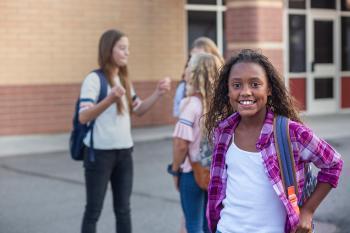Peer Pressure

Middle schoolers face peer pressure in many different ways, whether it’s to have the latest smartphone or app, wear trendy clothes, or go somewhere to hang out with friends. Your middle schooler will feel peer pressure when they are being pushed toward making certain choices—good or bad— by their friends or classmates.
What’s so difficult about avoiding peer pressure? Simply put, people want to be accepted and liked by people their own age.
Why Peer Pressure Can Work
Has your middle schooler ever given in to pressure—like when a friend begs to borrow something they don’t want to give up or to do something you say is off limits? Chances are your middle schooler probably has given into pressure at some point.
Giving into peer pressure can cause people to feel …
- Sad
- Anxious
- Guilty
- Weak
- Like they are being pushed around
- Disappointed in themselves
Everyone gives in to pressure at one time or another, but why do people sometimes do things that they really don’t want to do? Here are a few reasons. They…
- Are afraid of being rejected by others
- Want to be liked and don’t want to lose a friend
- Want to appear grown up
- Don’t want to be made fun of
- Don’t want to hurt someone’s feelings
- Aren’t sure of what they really want
- Don’t know how to get out of the situation
Middle schoolers need to know that when they face pressure, they can stand their ground.
How Peers Pressure
Almost everyone faces peer pressure once in a while.
The first step to standing up to peer pressure is to be aware of it. When middle schoolers can spot peer pressure, they are more likely to be able to deal with it. You can help your middle schooler recognize the different things people do to pressure others, such as:
- Put-downs – insulting or calling a person names to make them feel bad
- Rejection – excluding someone or threatening to end a friendship or relationship
- Reasoning – telling a person reasons why they should try something or why it would be okay if they did
- Unspoken pressure – feeling like they need to act or dress a certain way or do the same things they see others doing without anyone saying anything to them
In the section titled “The Right to Resist,” your middle schooler can learn skills to help them overcome peer pressure no matter what form it takes.
Peer Pressure Can Be Good, Too
Peer pressure isn’t all bad. Friends can pressure each other into some things that will improve their health and social life and make them feel good about their decisions.
Ask your middle schooler to think of a time when a friend pushed them to do something positive or to avoid something negative.
Here are some good things that friends can pressure each other to do:
- Be honest
- Avoid alcohol and drugs
- Don't smoke or vape
- Be kind
- Respect others
- Work hard
- Exercise (together!)
Middle schoolers can use positive peer pressure to help each other resist bad peer pressure. Some lines they can try are …
- “We don’t want to drink.”
- “We don’t need to drink to have fun.”
- “Let’s go and do something else.”
- “Leave them alone. They said they didn’t want any.”
NOTE: That little word “We” holds power. Middle schoolers can use it to rescue friends from negative peer pressure.
Talk to your middle schooler and ask them to share examples of good pressure that they or their friends have used to help each other.
Handouts for Adults to Share with Middle Schoolers
- The Peer Pressure Bag of Tricks [PDF – 449 KB]
Role-Playing Exercise for Adults to Lead
The Peer Pressure Bag of Tricks
Can your middle schooler figure out what kind of pressure is going on in each scene?
- Guide for Adult Leader
- Script to Share with Middle Schoolers [PDF – 3,978 KB]
Spoken vs. Unspoken Pressure
This activity illustrates the difference between two types of peer pressure: spoken and unspoken pressure.
- Guide for Adult Leader
- Script to Share with Middle Schoolers [PDF – 1,292 KB]

